Clematis Anna German - how to care for a plant
Clematis Anna German was bred in 1973 by the Soviet breeder Maria Sharonova. The cultivar Luther Burbank was taken as a basis, subjected to free pollination. The resulting clematis was named after the famous Polish singer Anna German. An unpretentious large-flowered variety with pale blue buds and is now loved by gardeners around the world.
- Description of the variety
- Landing features
- Organization of the place
- Preparation of planting material
- Landing technology
- Care
- Watering mode
- Mulching and loosening
- Tying
- Top dressing
- Trimming and shaping
- Preparing for winter
- Reproduction
- Cuttings
- Layers
- By dividing the bush
- Diseases and pests: treatment and prevention
- Use in landscape design
- Testimonials
- Useful videos
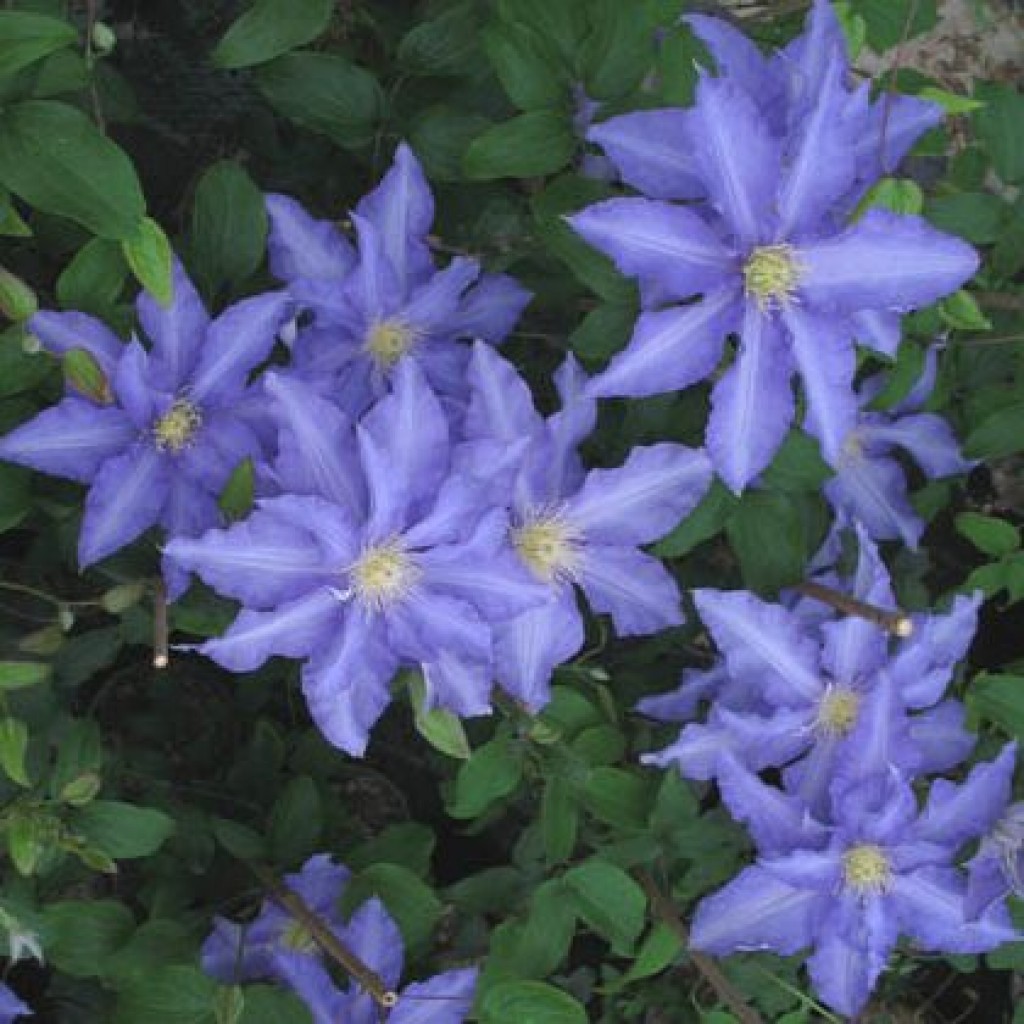
Clematis anna german
Description of the variety
The variety is medium-sized, the shoots reach 2.5-3 meters in length. However, with timely pruning, they rarely exceed 2 meters. In warm regions, the first flowering begins in May and lasts a month. The second time the bush blooms in August. In colder climates, budding time shifts. In the north of Russia, the variety is rarely grown outdoors; it blooms only once in the middle of summer.
The flowers are very large, can reach 20 cm in diameter. They are flat, have 6 elongated petals up to 7 cm in length. Their color is blue, slightly darker at the edges. Sepals have a fancy wavy shape with three grooves in the middle, which gives the flowers a special decorative effect, it is difficult to confuse them with another variety. Stamens are green-yellow, fluffy, sprinkled with pollen.
Interesting! It is noticed that the farther south the area of growth of this plant, the more terry flowers bloom on it. In cold regions, they are flat, with slightly wavy edges of the petals, they look much more modest than their southern "neighbors". The leaves are tenacious and flexible, on long stalks, with the help of which the vines cling to the support and hold on to it.
Landing features
The Anna German variety is quite thermophilic. In the spring, the buds on the shoots begin to wake up at a temperature not lower than +8 0С, and it grows only when +13 0С and higher is established. It should be planted in open ground either in April-May or in October-November, before the first frosts. When purchased in a container - in any warm month up to September.
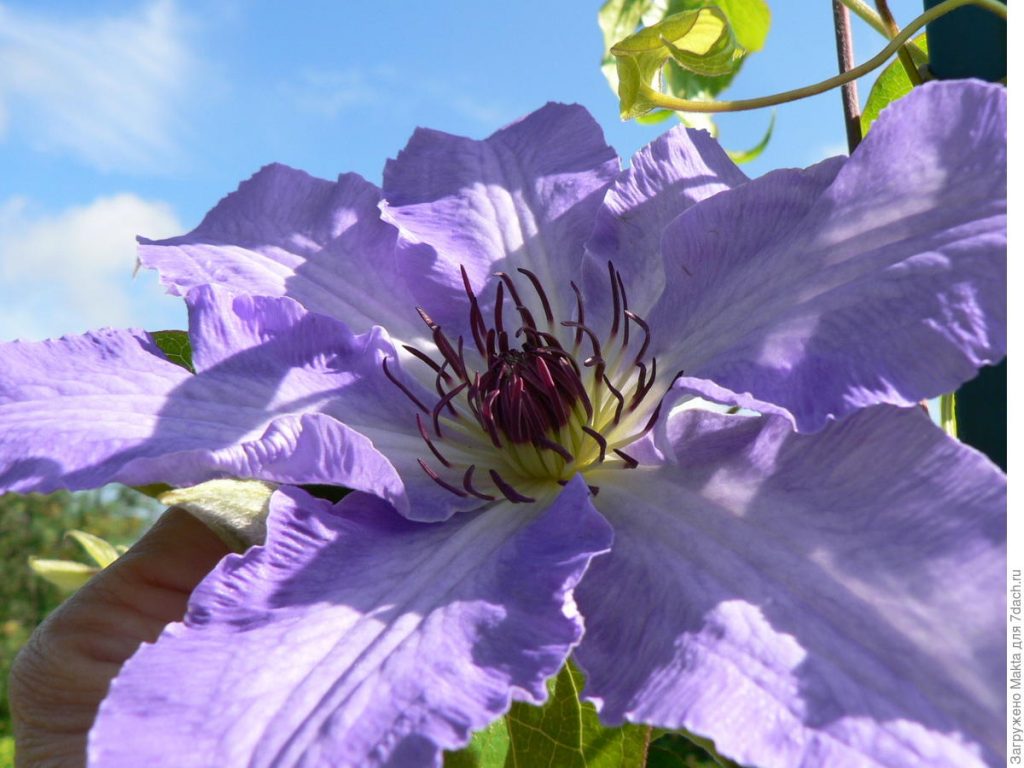
Clematis anna german photo
Organization of the place
The variety is not picky about lighting, it can grow in partial shade, for example, behind a building wall. The northern side of the site is rarely used for decorative flowers, but for clematis Anna German it is quite suitable. The main thing is that it is not a lowland, where water will flow after precipitation. It is undesirable to plant a bush under a wall so that streams of rain pour on it. The distance between the bushes should be 100-110 cm.
When planting in spring
A pit measuring 60x60x40 is prepared in November. Drainage is laid at the bottom. Its thickness depends on the depth of the groundwater. If they are closer than 2 meters from the surface, the drainage should be multi-layered: red brick, broken shards from earthenware, stones, rubble, large pebbles. Such protection from excess moisture is useful for clematis, which has a tendency to root rot.
Nutrient soil is poured over the drainage.It is important to do this in the fall, so that during the winter the soil will settle, and possible pests living in the soil will die. After the initial preparation of the landing site, they do not cover it, leaving it simply under a layer of snow.
When planting in autumn
The seedling must be hardened in advance before planting in autumn. Having planted a thermophilic clematis immediately after home maintenance in the ground, there is a risk of ruining it. Late summer nights are cold and the seedling is accustomed to room temperature. 2-3 weeks before planting, they begin to take it out into the garden in a pot. At first, only during the day and for a short time, then for the whole day, taking them to the house for the night.
A seedling adapted to the street will take root more easily, its root system will have time to start growing before the onset of frost. In the future, the planting technology does not differ from the spring one. Planting in the ground in the fall is preferable, the seedlings tolerate the stress of a change of place more easily, and flowering occurs then a year earlier.
Preparation of planting material
The Anna German variety is quite rare. It is better to buy it in nurseries, where there will be no risk of "running into" unscrupulous buyers. But even there, seedlings must be checked before buying. A healthy plant has no damage on the trunk and branches, the leaves are smooth and green, without tubercles and yellow areas.
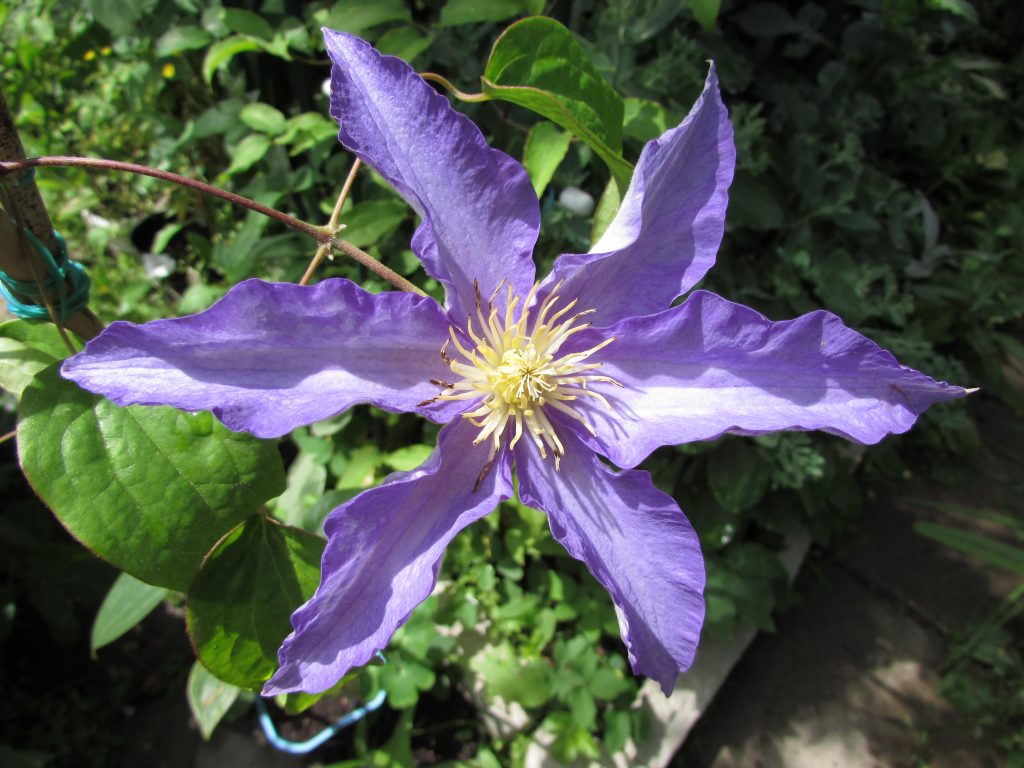
Clematis anna german reviews
It is not always possible to inspect the root system upon purchase. But before planting, it is better to carefully check the roots for rotten parts. They must be removed with a sharp knife and the sections must be treated with any fungicide (or simply activated carbon). The main central root cannot be damaged - the plant will get sick and die.
Landing technology
A soil prepared for planting is poured into a hole prepared in advance on top of the drainage. Its composition is not universal - you need to focus on the type of soil:
- If the soil is clay, sand, peat and leaf turf are added to it. This will reduce acidity;
- If the soil is peaty, sand and humus are added (purchased nutrient soil for seedlings is suitable);
- Sandy soil is poor in nutrients, you need to add humus, clay, compost to it;
- If the acidity of the soil is increased, lime is added to it. Dolomite flour also neutralizes the soil well.
A mound is built from the soil, a seedling is placed on it, and the roots are straightened. A support is installed nearby so that the roots are not touched. Only after that the seedling and the support are covered with earth. The trunk of the clematis should be covered with a layer of soil 10-15 cm above the root collar.
The seedling is watered immediately after being placed in the ground. It will take 5-10 liters of water. After watering, the soil will settle and it must be poured around the trunk to protect the root collar. The last step is to mulch the soil around the bush with peat, grass cuttings or garden soil.
Care
The health of the plant and the duration of its flowering depend on proper care. Anna German is not the most demanding variety, but without observing certain rules for watering, fertilizing, pruning and wintering flowering, you can never wait.

Clematis Anna German description
Watering mode
The soil for the Anna German variety should be moderately moist. As the bush matures, it will need more moisture. Underfilling is dangerous for the flower - it inhibits growth, does not form buds, and loses leaves. A lack of moisture will kill a healthy adult plant in just a month.
When planting in the spring, they begin to water it every 2-3 days. It is better to take settled or rainwater for this. In the heat, watering is necessary for a young plant daily to form small roots. Additionally, the bush is sprayed from a spray bottle. The main thing is that the water does not fall on the blossoming flowers.
There is an unusual and effective way to ensure a constant flow of moisture to the roots. Plastic bottles with a cut-off bottom are put in around the bush. When it rains, they will fill with water (or fill them on their own), and moisture is gradually absorbed into the ground. These bottles are also used for liquid fertilizing.
Mulching and loosening
The roots of the Anna German variety are branched and powerful, but grow close to the soil surface. In order not to overheat and not overdry, their top layer of soil is mulched. For this, hay, sawdust, loose garden soil or humus are suitable. The main thing is that the mulch is dry. The layer of such a shelter should be at least 20 cm.
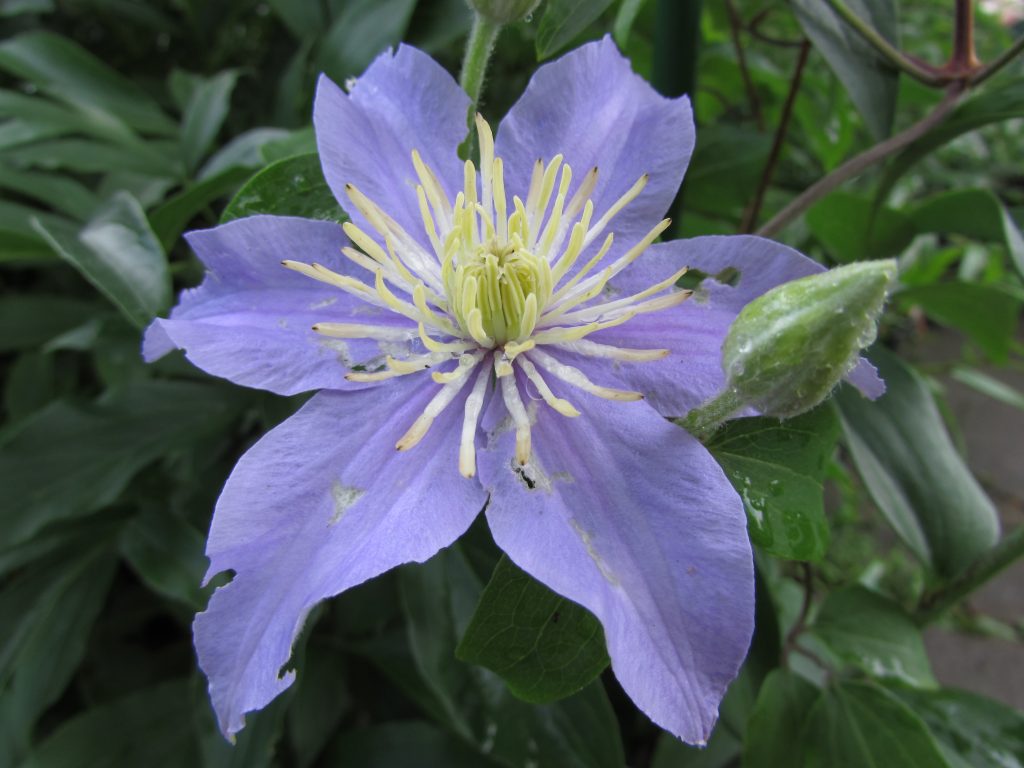
Clematis hybrid anna german
Annual plants are suitable for protecting the roots from the sun. They are simply planted under a bush and left like that for the summer. Weeding is not required, annuals will not prevent the bush from growing, and after wilting, they will serve as additional food for its roots.
It is better to plant marigolds, nasturtium or calendula under the vines. They will not only cope with their main task, but will also repel insect pests. Clematis will be under their reliable protection all season. Many gardeners do just that, dispensing with aggressive "chemicals" - powerful insecticides.
Tying
Flexible and long shoots need strong support. The Anna German variety is not the tallest, but still not less than 2.5 meters. About what the vines will cling to as they grow, you need to think in advance. The support should not be lower than the bush itself, otherwise it will look ugly and sloppy.
Even if the shoots themselves braided the support, they should be tied up in several places for fidelity. The bush must not be allowed to fall from the wind, the damaged branches cannot be restored. The plant will spend all its energy on the formation of new shoots, and flowering will suffer. Anna German belongs to the second type of pruning, which means that complete breaking off of branches can destroy the plant.
Top dressing
The variety is distinguished by its exactingness to the composition of the soil. It will not work to achieve lush flowering without the introduction of organic fertilizers and mineral complexes. From early spring to frost, clematis is fed twice a month. Both dry and liquid fertilizers are suitable. When feeding the plant, it is important to observe the required application time and dosage:
- In the spring, the buds begin to swell, the plant is watered with a solution of ammonium nitrate (20 g per bucket of warm water) or a solution of chicken manure (1x15). A bucket of fertilizer is poured under each bush. Nitrogen mineral complexes are also used;
- In May, during the formation of buds, phosphorus and potassium are required. Wood ash is added under the bush, sylvinite and superphosphate are added.
- In the summer, it's a good idea to prevent diseases and pests. To do this, prepare a solution (for a bucket of water, 1 g of boric acid, 3 g of potassium permanganate). Water the plant or spray the leaves with such a means.
- After the first flowering, the plant is fed with mineral fertilizers to give strength. Then in the fall it will again form buds and show all the splendor.
- In preparation for winter, after pruning, a month before frost, phosphorus-potassium dressings are applied under the bush. Additionally, wood ash is added under the trunk circle.
As folk remedies for improving growth and flowering are suitable:
- Nettle tincture. Fresh nettle greens are infused in a bucket of water for about 2 weeks.
- Potato broth. After boiling the potatoes, the cooled broth is poured under the bush.
- Onion peel. It is infused for 4-5 days, then it is used for watering or spraying the plant.
- Coffee grounds. When dried, they are poured under a bush, mixed with the top layer of soil.
- Tea brewing. It is poured out with the remains of sweet tea in a cooled form.
- Ash infusion. Insist on water for a day, watered at the root.
Trimming and shaping
The variety belongs to the II pruning group. This means that the buds are formed first on overwintered shoots, and then again on young annual shoots. This type of bloom requires a two-step pruning. The main pruning takes place in the fall, during the transition of the plant to the dormant period. Before the procedure, it is required to disinfect the garden tool. Getting an infection into a wound is dangerous for clematis of all varieties.
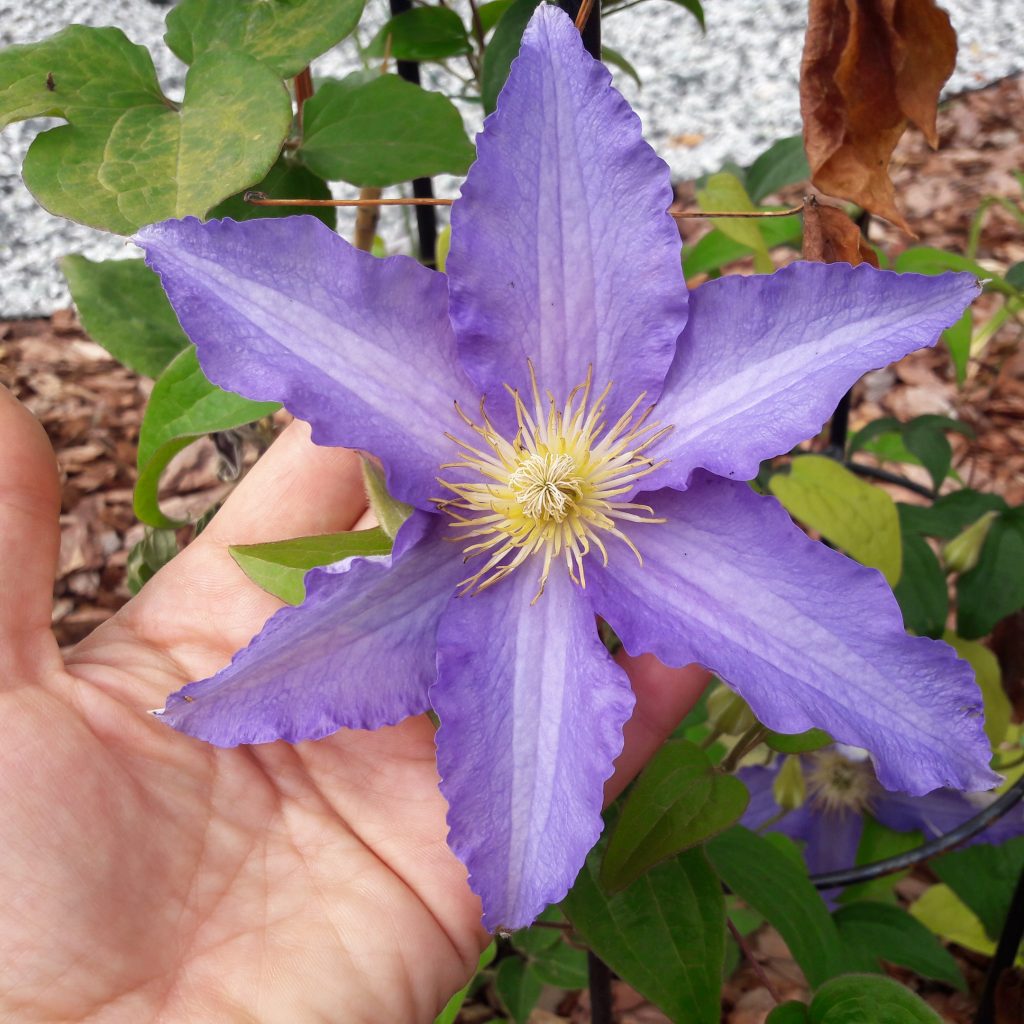
Clematis anna german trimming group
First, remove all dried and deformed vines. They are cut off completely. The rest are cut so that 1.5 meters of each stem remains above the ground. If there are many of them, the strongest leave, and the rest are completely cut off. 10-12 healthy shortened shoots are enough for successful wintering and further flowering of the bush.
If the task is to get an earlier budding next year, annual shoots are cut off in a quarter, removing the wilted part. You can remove them to the first fully developed leaf - this will allow the bush to bloom more evenly. It is very important to adjust the correct number of shoots in the bush (12-15), for this some of them have to be removed completely.
Preparing for winter
The main stage of preparation for wintering is to transfer the plant to a dormant state. To do this, they stop fertilizing it with nitrogen, instead, in October, rotted manure is introduced into the soil under the bush. It will serve not only as a top dressing, but also as a heater for the winter. Organic matter generates heat as it decomposes, so the bush will not freeze.
Before building a shelter for the winter, clematis is watered abundantly. Then fungicides or copper-containing preparations are introduced into the soil. Fungi have already begun to adapt to the latter, so finding an effective drug is becoming increasingly difficult. Gardeners often prefer biofungicides such as: Fitosporin-M, Fitop Flora-S. They also treat the plant in early spring, immediately after removing the shelter.
You can completely cover clematis after the first frost - in November. The second type of pruning is done 1.5 meters above the ground. They need to be bent neatly to the ground and laid on a previously prepared "pillow" of sawdust. Covering the vines with slate on top is the best option for clematis. So they will breathe under the snow and will not rot.
First-year seedlings need more thorough frost protection. Wooden "houses" are erected for them, which are covered with spruce branches or covered with sawdust. Before being placed in the "house", the bush must be covered with dry earth to a height of 30-40 cm.
Reproduction
Anna German is a hybrid variety of clematis, so it makes sense to propagate it only vegetatively. The seeds will not retain the properties of the mother bush, the variety will turn out to be different. Therefore, this variety is not propagated by seeds at home.
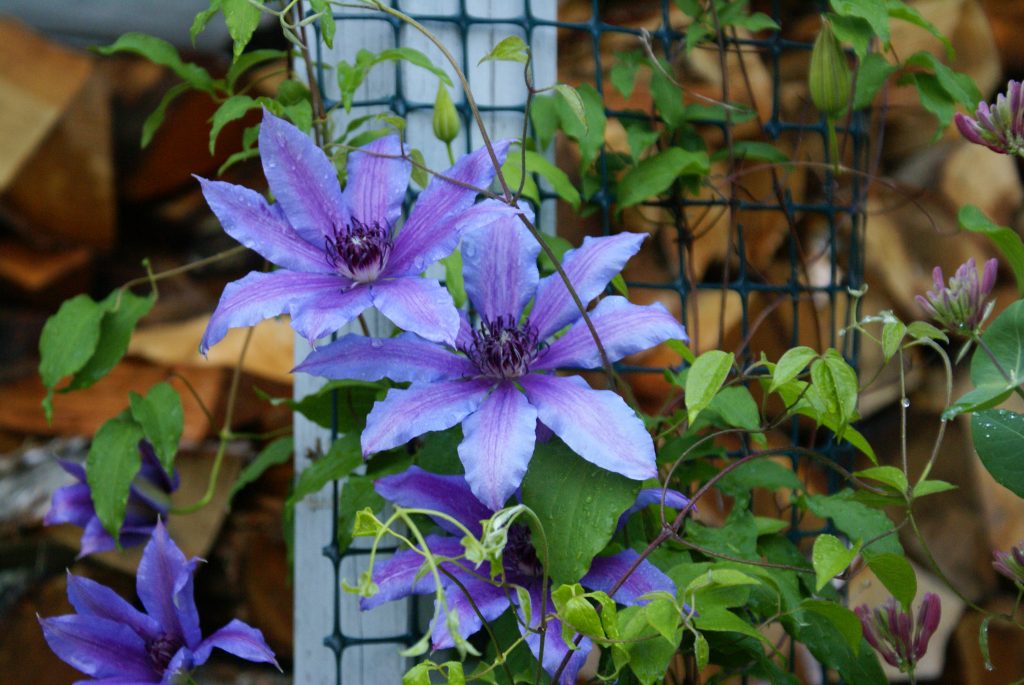
Clematis anna
Cuttings
Cuttings are prepared from adult shoots by cutting them out of its middle. The upper and lower parts of the vine are not suitable for these purposes. Each cutting should have 1-2 internodes (2 cm above the top and 3-4 cm below the bottom). Planting material is soaked in Kornevin for a day. Then they are planted in small containers with soil.
The composition of the soil can be different, the main thing is that it easily allows water and air to pass through. A mixture of perlite, vermiculite and peat is fine. For better rooting, the cuttings are placed under a lamp, the temperature should be at + 25 ° C. Periodically, the seedlings are sprayed with warm water. As soon as new leaves begin to grow, this means that the cutting is rooted.
Gardeners prefer to keep young clematis seedlings in a greenhouse for the first 2-3 years. Only in the 4th year are they planted in open ground in a permanent place. This strengthens their immunity, and flowering occurs earlier. After the greenhouse, having gained strength, the plants practically do not get sick and winter well even in severe frosts.
Layers
This is a very simple and reliable breeding method. A liana is taken away from an adult bush and buried in the ground in the middle. At the edges it is fixed with heavy stones. The intended rooting site is often watered. After a month, the shoot starts up roots, but for a long time it feeds on the mother bush.
Some gardeners remove the seedling in the fall, placing it in a permanent location. However, most advise to leave the rooted layers in conjunction with the main bush throughout the winter, and carry out the separation in the spring. So the survival rate of young plants is much higher. In addition, such a seedling will bloom a year earlier than separated in the fall.
By dividing the bush
This breeding method also serves as a method for rejuvenating the age bush. Clematis Anna German is not very durable, it has to be renewed every 5-6 years. There are two ways to divide a bush: radical and gentle. With sparing, everything is simple - a part is cut off from the bush with a shovel and deposited separately. The next year, the new plant will be ready to bloom.
A radical method is used on old bushes, heavily thickened and poorly flowering. They dig up clematis, wash off the roots, separate them into separate parts. From one bush, 5 to 15 small seedlings with a separate growth point are obtained. Each of them must be planted in pre-prepared holes near the dug-in supports.
Diseases and pests: treatment and prevention
The hybrid is characterized by strong immunity. The plant can get sick due to improper care or bad weather conditions. Most often, clematis suffers from waterlogging of the roots when a fungus develops on them. Different types of rot require different treatment, but the outcome is difficult to predict. It depends on the age of the bush, the degree and stage of the disease.
The most powerful tool in the fight against root and leaf rot is the Switch. Fundazol also helps if the disease is detected at an early stage. But it is always easier to prevent trouble, therefore, as a preventive measure, the plant is treated with Fitosporin twice a season. For the same purpose, a solution of potassium permanganate is used.
The main pests of clematis are nematodes. It is impossible to notice them in time, they settle in the roots and are not visible to the naked eye. There is no cure for this scourge. The plant is burned, the place is disinfected several times. After that, fertile soil is brought from another place and a new plant is planted.
In summer, clematis spoil slugs, and in winter, mice. Crawling aggressors are best collected by hand. Spraying the bush with a solution of ammonia helps (2 tablespoons per liter). The Ferramol preparation scattered around the bush, crushed lime or eggshells will prevent slugs from crawling close. Against mice, you need to more carefully cover the bushes for the winter.
Use in landscape design
Large-flowered clematis Anna German is suitable for decorating arches, gazebos, facades and porches of a house. By combining this variety with others that bloom at different times, it is possible to organize alternate, "conveyor" flowering in the garden. It will be fragrant all season, from May to October.
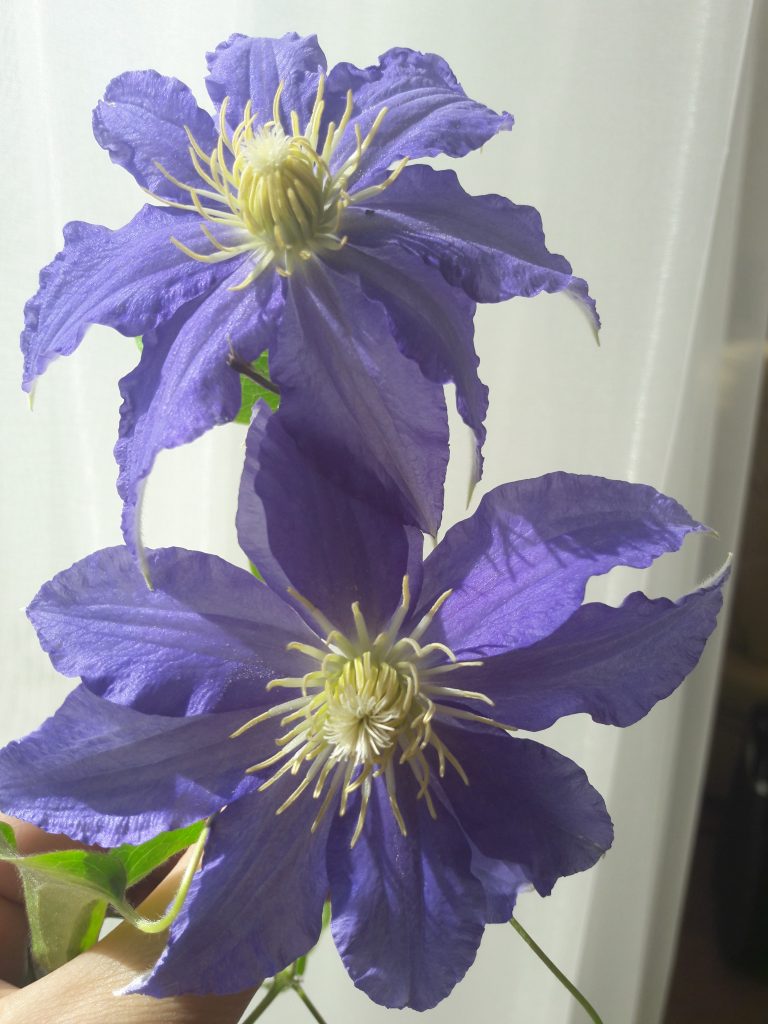
Clematis Anna German
Clematis is not too tall, so he does not need the construction of volumetric supports. Enough and small decorative arches or columns, openwork fences, railings from the porch. It will be possible to curl a large gazebo with vines of this variety only if you combine it with other clematis.
You can create compositions from hybrid clematis and roses, decorative grapes, lemongrass, climbing honeysuckle. Each of these plants complements each other, creating unusual fragrant corners in the garden that amaze with a variety of colors.
Testimonials
Gardeners speak well of the Anna German variety. It is resistant to disease, has strong immunity and perfectly tolerates even the most frosty winters. In some southern regions, the plant even does without shelter for the winter. One snow cover is enough for him there.
Everyone is delighted with the flowers of this variety. They are large and bright, especially if planted on the sunny side of the site. Clematis blooms for a long time, often re-blooms in September. This does not require any additional manipulations, except for fertilizing and competent watering.
The Anna German variety is loved by gardeners from different countries for its unpretentiousness and decorativeness, resistance to diseases and ease of reproduction. In a light and warm place protected from the wind, this clematis will grow for many years, blooming twice a season with large and beautiful pale blue flowers.

